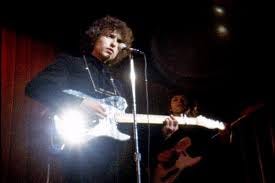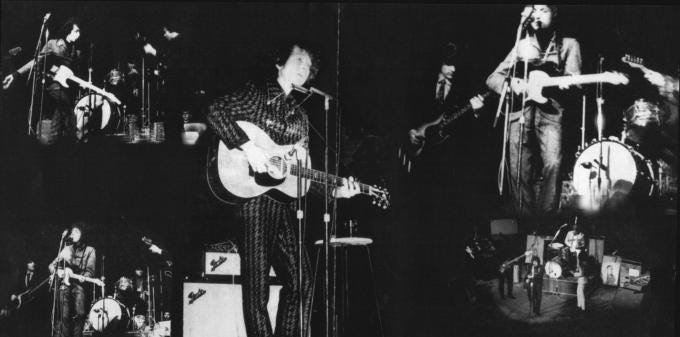58 years later, Dylan's back at Albert Hall
The Never-Ending Tour winds up in England in November.
Determining the actual moment of an athlete’s or a performer’s absolute peak is probably impossible. There are so many factors to consider, people have different opinions, expectations and evaluations and time itself can alter the way we see, interpret and remember things.
After watching Muhammad Ali/Cassius Clay utterly destroy Houston’s hulking Cleveland “Big Cat” Williams in three magnificent rounds in the Astrodome in November of 1966, there was no way Ali, who stopped Williams barely a minute into the third round, could ever have been better. He never was.
Some people might say the same thing about a moment six months earlier when Bob Dylan was winding up his explosive 1966 tour with a swing through the British Isles, winding up with two dates at London’s Royal Albert Hall, concert performances that were included in the 36-CD box set “Bob Dylan: The 1966 Live Recordings,” a collection that came out in 2016.
While a much bootlegged show from Manchester, England that was recorded at the Free Trade Hall on May 17 would probably get the nod from most Dylanites as his single finest concert performance - certainly of THAT period - there’s also a lot to be said about the two concluding tour performances at the Royal Albert Hall ten days later. Bob found the time - and inspiration (or substances) - to offer introductions, between-song-patter/ramblings that are hilarious, revealing and a testament to him sticking to his artistic guns, playing the music HE wanted to play, the hell with whatever the audience reaction might be. Especially if it was negative - which it often was.
The Manchester show, which included the legendary “Judas” moment, caught on film in the closing moments of “No Direction Home” was, for years, mistakenly titled “The Royal Albert Hall” concert, due to a labeling mistake. Musically speaking, Dylan and The Hawks are absolutely sizzling, the show is simply extraordinary. There was good reason for it to be bootlegged.
But the actual Royal Albert Hall concerts offer their own unique delights. And considering that Bob is actually RETURNING THERE FOR three shows the 12th, 13th and 14th of November, just a week after a Presidential election that could radically change America, wouldn’t it be great if - just for the hell of it - he decided to play the exact same set in the same order as he did in 1966.
But the actual Royal Albert Hall concerts offer their own unique delights. And considering that Bob is actually RETURNING THERE FOR three shows the 12th, 13th and 14th of November, just a week after a Presidential election that could radically change America, wouldn’t it be great if - just for the hell of it - he decided to play the exact same set in the same order as he did in 1966.
An acoustic set, of seven songs - all classics: “She Belongs To Me,” “Fourth Time Around,” “Visions Of Johanna,” “It’s All Over Now, Baby Blue,” “Desolation Row,” “Just Like A Woman,” and “Mr. Tambourine Man.”
Then an electric set of “Tell Me, Mama,” “I Don’t Believe You,” “Baby, Let Me Follow You Down,” “Just Like Tom Thumb’s Blues,” “Leopard-Skin Pillbox Hat,” “One Too Many Mornings,” “Ballad Of A Thin Man,” and capped by “Like A Rolling Stone.”
Of course, it would never happen. Bob hasn’t played some of these songs for decades. And the only Hawk left - Garth Hudson - surely wouldn’t be up for a cross-the-Atlantic show. But the tour ends there, just as it did in 1966. And at 83, it would be a perfect finish to his extraordinary performing career.
For those 1966 shows, remember that the British shows came just a couple of days after Bob Dylan’s 25th birthday which he had celebrated with a rousing concert in Paris by hanging an enormous American flag behind him and The Hawks just to provoke his French audience. It did. (Remember: They weren’t The Band just yet. Levon Helm had yet to return.)


And since provocation was precisely what Bob Dylan had in mind, these concerts displayed an artist at his absolute peak, confronting his audiences with a new and challenging music that was loud, hard-edged, uncompromising - about as far away as an artist could go from getting his tunes on the radio. Which was the idea!
As a songwriter taking the stage armed with an acoustic guitar and harmonica, Dylan’s poetic, evocative lyrics changed popular songwriting. But after witnessing the success of The Beatles and other artists recording his material, Dylan decided he would “go electric” and debuted the sound to much controversy at the Newport Folk Festival.
The controversy followed him around the country, then the world as the 1966 tour went through Australia, Denmark, Ireland, Wales, winding up with the shows at the Royal Albert Hall. By then, newspaper reports had followed the band and British audiences, normally very supportive of Dylan, began to talk back in mid-show. That was certainly the case by the tour’s end at the Royal Albert Hall.
Before the show’s next-to-last song, “Ballad Of A Thin Man” where Bob takes to the piano, a fan hollered out “Can we have the good stuff again?”
And Bob fires back: “The good stuff from the bad stuff? It’s all the same stuff!”
Then, weary of the tour, the constant criticism, maybe feeling frustrated that the finest, most revolutionary music of his life wasn’t delighting fans, he got nasty.
“You’re not going to see me anymore and I’m not going to see you anymore,” he said, sounding tired, stoned, irritated all at once. Then, more than a bit of sarcasm. “All you people are wonderful. You’re the greatest people, haha..(Somebody hollers something back). Why don’t you just all say what you want to say for a minute. Say anything you wanna for a whole minute. I gave you one minute. You got a watch? (More hollering.) "You’re just marvelous. (Starts to play the chords.) I’d trade places with you. Would you trade places with me?”
Bob Dylan, just turned 25, offering possibly the greatest music of his life on the 1966 Tour.
A few songs earlier, he had given a long, quite clearly stoned rap before “Just Like Tom Thumb’s Blues.”
“There’s a long story behind this song, this song has to do with a painter, this here certain painter is just a wonderful cosmic painter who is completely unknown to the universe and uh, he, uh, lives in Mexico City and he travels between there and Del Rio, Texas which is one of the United States, uh, one of the bigger ones. And this happens to be all about him, of course, he’s an inspiration and he’s into this song.
“I’m just telling you this in case you think that there’s anything that you’re MISSING (emphasizes that word), you understand? I don’t want you to think you’re OUT OF IT. (Editor’s note: LIKE HIM!) I’m sick of having people thinking “What does that mean?” It just means nothing... (Cheers.)
“This is, uh, I mean, uh, it’s impossible to explain what this one means, because obviously it’s…(crowd reaction) Oh, come on. Uh, so this specific (more crowd noise) You’re talking to the wrong person, man. In any case, it’s just going to take a second (Cheers), this is just going to take a second and I’m the last person to explain any of these songs but I want to do this because this is the last concert here. I mean, if you don’t want me to do it, just say so. I don’t care. I couldn’t care less. We’ll just do, we’ll play the music and leave and uh, you and you can go out and read some books. (Then, as the music cranks up) Read J.D. Salinger.”
Before the last song, “Like A Rolling Stone,” perhaps, in a moment, recognizing the courage that all these musicians showed, enduring the taunts, the boo’s, the things thrown up on the stage, Dylan says he’s never done this before and introduces all of the band.
Then he looks out at the audience and says, “You promised me you were going to leave. It doesn’t mean a thing.
“These guys are all poets, you understand? If it comes out that way, it comes out that way. All poets. This song here is dedicated to the Taj Mahal. We’re going to leave after this song and I want to say goodbye to all you people. Great people…you’ve been very nice people. Here you are, sitting in this great huge place. And (the sarcastic tone returns) we’ve enjoyed every minute of being here.” Then the drums kick in, the organ soars and Bob opens his mouth…”Once upon a time…”
It would be years before he was on a stage again, even longer before he toured with The Band (1974, many of the soundboards from that tour will be coming out in September, a 27-CD set.)
Years later, guitarist Robbie Robertson looked back. “What we were doing, nobody, nobody had quite done that before,” he said. “It was a different approach to the music. It had a dynamic thing to it, and an explosive thing to it, and a raging thing to it. It had a violent quality along the way to trying to find the beauty.
"We were doing something that people highly objected to, and it was quite a feeling to be doing that and really dedicated to it and have it feel like the world didn't believe in it.
"I have to take my hat off to Bob for not caving, because a lot of people would have just said, 'Well, the audience isn't really liking this very much, we should change it up.' But he didn't budge, and we stuck with him, and in time it's been proven that the world was wrong and we were right. That's quite a feeling."
Bob Dylan, at 83, back at the Royal Albert Hall 58 years later. Bet the audience won’t be talking back this time. Darn it.
John Nogowski is the author of “Bob Dylan: A Descriptive, Critical Discography 1961-2022, 3rd edition” available on Amazon.





Nice writeup. Makes me wish I'd have picked up the 66 box when it was released. Your piece really put the whole thing in perspective for me. I think I am probably not alone in the sense that these early to mid 60s Dylan years sorta get taken for granted, even by hard core bobcats.